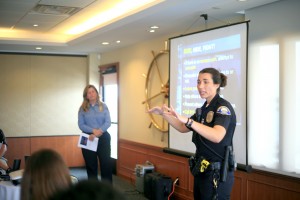 How should you respond to an active shooter?
How should you respond to an active shooter?
Newport Beach Police Department Crime Prevention Specialist Andi Querry and NBPD Officer and School Resource Officer Marie Gamble provided a number of answers to that question during the Newport Beach Chamber of Commerce’s Networking Luncheon Speaker Series at the Bahia Corinthian Yacht Club on Wednesday.
The topic of the luncheon was “Are YOU Prepared for an Active Shooter Situation?”
“Our goal today is that if you find yourself in this type of situation that you will at least be thinking kind of outside the box,” Querry said. “We’re giving you some tools and some things to think bout and some planning (ideas) so that you will survive an incident like this.”
Both emphasized that it could happen anywhere, including Newport Beach.
Active shooter situations are unpredictable, they evolve very quickly, victims are usually selected at random, and no location is off limits, Querry said.
An FBI study discovered that nearly half (45.6 percent) of these type of incidents happen in a commercial setting, like a mall or cafe.
The next most common (24.4 percent) location are schools.
“Unfortunately, our kids are targets,” Querry said.
There have been 160 incidents across the U.S. between 2000 and 2013, according to the FBI study. From those cases, 486 people have been killed.
During the last seven years of the study the annual average number of active shooter cases increased by half, Querry noted.
“It’s so unfortunate,” Querry said, “but it is so prevalent, that we have to stay on top of it.”
About 60 percent of these incidents ended before police even arrived, Querry noted.
Although NBPD will arrive quickly, likely within minutes, it could be all over by then, she said.
Most of these incidents happen very fast, she added, often ending when the suspect(s) hear the sirens and kill themselves.
Nearly half the audience members raised their hands when Querry asked the crowd who thought they’d survive if a shooter came in the room at that moment.
“Good,” she replied, “You’ve got to have the mentality that you’re going to survive. That’s got to be the first thing you put into your head.”
Querry advised people to pay attention to their surroundings during their day to day lives. Locating the exits upon entering a room is a good idea, she said.
She also emphasized not to be paranoid. The chances of it happening are very low, she said, but people should be prepared and alert.
They also answered a few questions from the audience. Most suspects in active shooter situations are male. Most of them are also not on drugs or alcohol (surviving suspects have said they wanted clarity before the attack) and most do not have a mental disorder. The reasons are varied. Most plan the event out.
They focused on the Department of Homeland Security’s recommended respond in an active shooter situation: Run, Hide, Fight.
Often, but not always, depending on the situation, the best action to take is to run.
The only way to prevent getting shot is to simply “not be there,” Querry said. That is why the first reaction should be to run.
Leave any belongings behind and wait to call 911 until in a safe location.
“If you can get out. Get out,” Querry said.
Run. Keep moving. Break a window if needed.
“A door is not your only way to get out,” Gamble said.
Encourage others to leave as well, Querry added, but don’t stay behind because of others. Many people freeze, she said, or don’t believe what they heard were gunshots.
“Gunfire might not sound what you think it will sound like,” Querry said.
When exiting, police recommend people to raise their hands and spread their fingers so police can immediately identify non-threats.
If running is not safe or impossible, hiding is the next best option for survival.
When hiding, pick a spot out of view of the shooter, preferably behind a large object that could potentially stop a bullet. Block the entryway to the hiding place and lock any doors, if possible.
Simply barricading the door shut may help deter or stop the shooter, Gamble said.
They also emphasized to completely silence, not vibrate, any cell suspect.
“Their goal is to kill as many people as possible,” Querry said. “There is no negotiation.”
Fighting is the last resort, Gamble said.
“They are looking for easy victims,” Gamble said. “Don’t make it easy.”
She encouraged people to throw whatever they can – purse, chairs, books, fire hydrant – if the shooter approaches them. Throwing things will distract the shooter, she explained.
Simply running or zig-zagging will give the suspect a moving target and make it harder to hit, Gamble added.
“Just by bobbing and weaving, that can help,” she said.
All of these moves will help, she added.
Playing dead is not a good idea, Querry added.
“If you do decide to act,” Gamble said, “you do that 110 percent. Do not hesitate. You have to jump on it right away, because if you don’t, it’s not going to work.”
Then take off running, she added.
There is no one correct reaction, Querry emphasized. There is no way to predict what the suspect may do, she said.
“You have to be thinking every second,” Querry said. “Having a reactive response will help save your life.”




